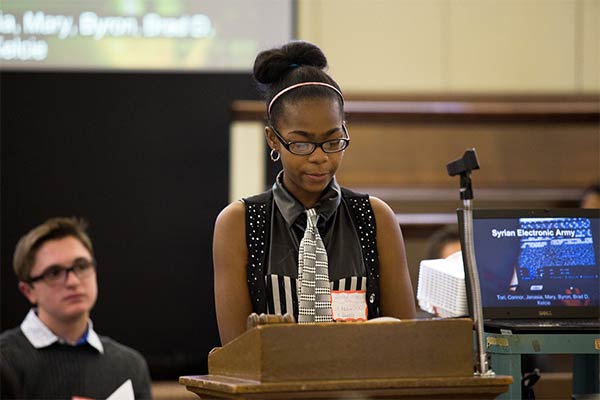On November 6, 2013, the ninth grade class at Moorestown Friends School simulated an international discussion on Syria in the Friends Meeting House as part of their history curriculum. Students represented one of twelve groups involved in the current Syrian crisis, presenting possible solutions to the conflict and discussing potential paths to peace.
The represented parties were the Free Syrian Army, the al-Nusra Front, Alawite and Sunni religious groups, the Democratic Union Party, the Syrian Islamic Liberation Front, Iran, Russia, the Ba’ath Party, the United States, the United Nations Office for the Coordination of Humanitarian Affairs, and the Syrian Electronic Army. Students researched the history of the conflict, including the 2011 protests demanding the resignation of President Bashar al-Assad, the deployment of the Syrian Army, and the use of chemical weapons.
“The factions represented in the simulation ranged deeply in beliefs, so it really showed me the struggles that people can have when trying to resolve a conflict with so many components,” said student Melissa Abrams. “The one thing that stood out to me was that making peace with other people who have extremely diverse positions can be very difficult. I now have a greater appreciation for the people working in international affairs, because their jobs are not easy.”
Students spent three weeks preparing for the simulation, researching the history of Syria and other nations involved in the conflict. After acquiring a basic knowledge of the events leading to the Syrian civil war, students were divided into groups representing the factions currently involved in the crisis.
“This simulation was designed to give them firsthand experience of what happens when a government breaks the social contract, and how all the groups involved (the stakeholders) react and cope with that crisis,” said History Teacher Dorothy Sasso. “The goal was to arrive at a peaceful joint resolution that reflects the interests of all groups involved.”
Because some of the factions were difficult to research, students were encouraged to delve deeply into articles and books and to think critically about the biases of their sources. They shared information with one another and looked at the crisis from the perspective of the faction to which they were assigned, attempting to understand the human motivations behind the violence.
“Simulations like this are most definitely a good way to learn,” said Janasia Copling, who presented on behalf of her group. “They teach you how to cooperate and work as a team. It strengthens problem solving abilities while broadening your view of the topic. Lastly, it allows kids to absorb and understand more information since it is coming from the mouths of their peers.”
Abrams agreed. “This project included working with others, writing, public speaking, negotiating, and most importantly compromising. All of these skills are essential for a student to develop. I really enjoyed this experience because I felt as though I had a voice in world events.”
After presenting their stances and talking amongst each other, the 12 groups worked together to create a peaceful mock resolution to the crisis. The factions called for current President Bashar al-Assad to step down and laid the framework for a more democratic government in Syria which allowed for representation from each group.
“I learned about where each group stood on the subject and what they were willing to sacrifice for peace,” said Copling. “Something greater I learned was the capabilities of young minds… I was really proud of the freshman class.”

